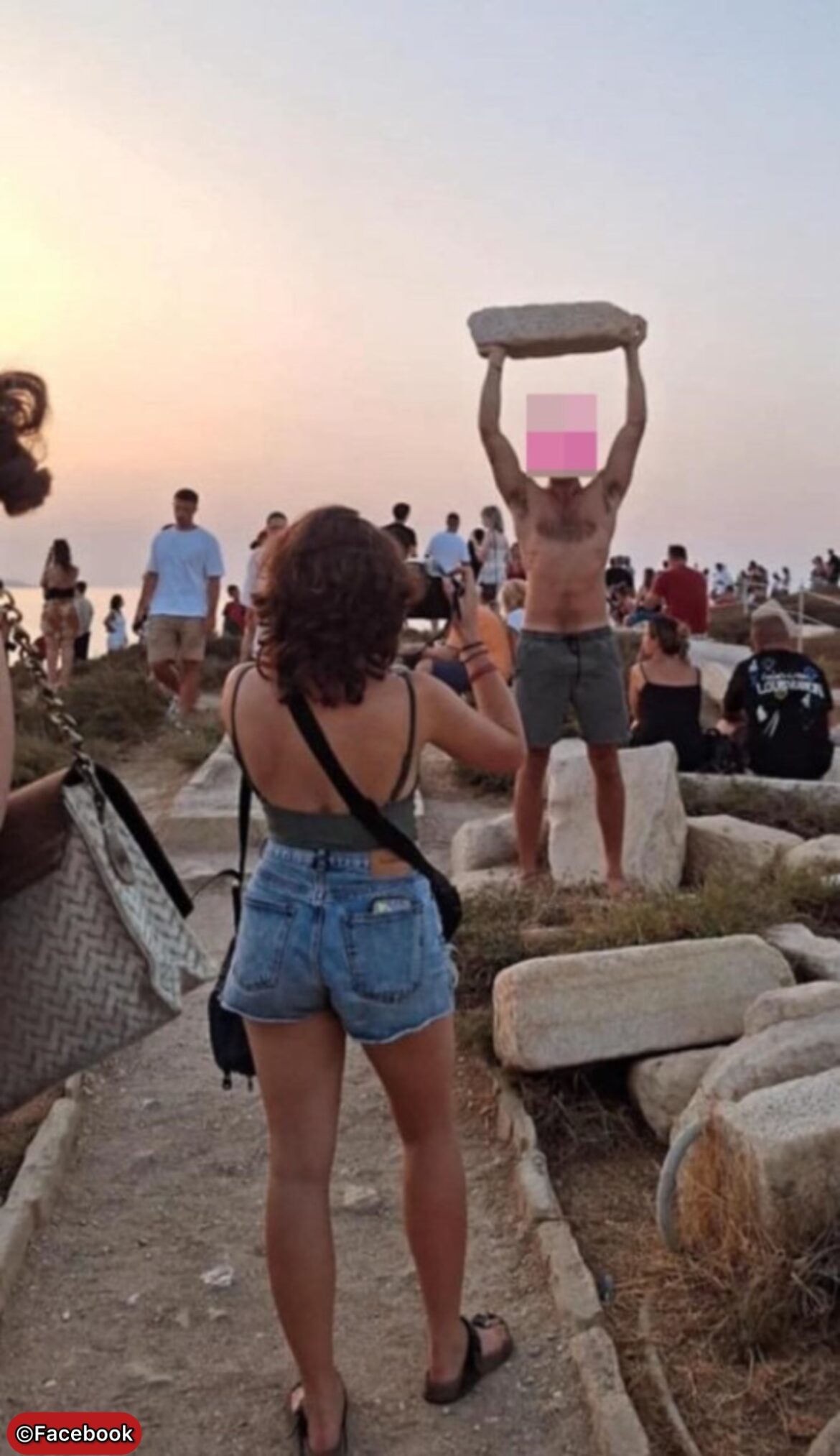A tourist has ignited fierce criticism across Greece after being photographed lifting a large piece of ancient marble at the historic Portara monument in Naxos, prompting calls for increased security at the vulnerable archaeological site.
Local resident Kiriakos Jr. Boulamatsis captured the shocking image showing a topless man hoisting what appeared to be a substantial fragment of white marble, seemingly removed from the grounds surrounding the 2,500-year-old temple gateway. A woman stood in front of him with her phone raised, apparently photographing the act.
The incident at the famous 20-foot-high marble doorway on the islet of Palatia has reignited debate about protecting Greece’s ancient treasures from overtourism and disrespectful behaviour. The Portara, constructed between 530 BC and the 6th century, is the sole remaining part of an unfinished temple dedicated to Apollo.
“Many words are poor. Immediate guarding and protection. Not today, yesterday. They crossed the limits. Wake up before it’s too late,” Boulamatsis wrote on Facebook alongside the damning photograph.
The concerned resident warned that without intervention, “only the hill with the steps” would remain of the historic site. He claimed such disrespectful incidents occur daily at the unguarded monument, which currently operates without formal security, ticketing, or access restrictions.
Social media users expressed outrage at the desecration, with one commenter calling it “disrespectful in every way” whilst another lamented: “It feels like people are becoming more stupid year after year.
Another frustrated local wrote: “Naxos is increasingly becoming a Disneyland and the visitors probably have money, but no respect and decency.”
Boulamatsis argued that in other countries, the perpetrator would have been “fined and deported” for such behaviour. The incident has highlighted the vulnerability of Greece’s archaeological sites, particularly those lacking adequate protection measures.
Naxos Mayor Dimitris Lianos confirmed the Ministry of Culture had been notified and has since deployed a guard to the gateway, though it remains unclear how long this security presence will be maintained.
“What the Municipality and the residents of the island want, and we have submitted it to the Ministry of Culture, is for an on-site restoration and promotion of this particular archaeological site,” Lianos told protothema.gr.
The mayor advocated for the site to be “maintained and operated in an organised manner, with a ticket and security, so as to ensure its protection and generate revenue that will be attributed to Culture.”
The Portara stands as one of Greece’s most photographed monuments, particularly famous for its spectacular sunset views when the sun appears to set through the ancient marble frame. Each of its four marble components weighs approximately 20 tonnes, carved from high-quality Naxian marble extracted from quarries 10 kilometres from the city.
The structure was commissioned by the tyrant Lygdamis, who envisioned creating a temple that would surpass even the Temple of Olympian Zeus in Athens. However, political upheaval led to the project’s abandonment, leaving only the magnificent gateway standing.
The incident comes as Greece grapples with managing overtourism at its archaeological sites. In 2023, authorities imposed a daily limit of 20,000 visitors at the Acropolis in Athens, down from peaks of 23,000, to protect the World Heritage site from deterioration.
Greek archaeologists and heritage advocates have long warned about the lack of a comprehensive strategy for protecting the country’s ancient monuments. Professor Angelos Chaniotis of the Institute for Advanced Study noted that “when monuments are an obstacle for construction works, large investments, or mass tourism, the economic interests take priority over the preservation of cultural memory.”
The controversy also reflects broader concerns about tourist behaviour at historical sites worldwide. Greece receives millions of visitors annually, with many drawn to its ancient monuments, creating tension between economic benefits and heritage preservation.
The unidentified tourist’s actions represent what locals describe as the worst example of a growing problem. The site’s location on a small peninsula connected to Naxos town by a narrow causeway makes it easily accessible but difficult to monitor effectively.
Heritage experts stress that the Portara, as a symbol of ancient Greek civilisation and architectural achievement, requires urgent protection measures to ensure its preservation for future generations. The monument has already suffered losses over centuries, with marble blocks removed during Venetian rule for construction projects elsewhere on the island.
The incident has prompted renewed calls for Greece to implement stricter measures at vulnerable archaeological sites, including mandatory guided tours, security personnel, and hefty fines for those who damage or disrespect ancient monuments.
As tourist numbers continue to rise post-pandemic, the challenge of balancing accessibility with preservation becomes increasingly critical for Greece’s cultural heritage sites.
Follow for more updates on Britannia Daily



